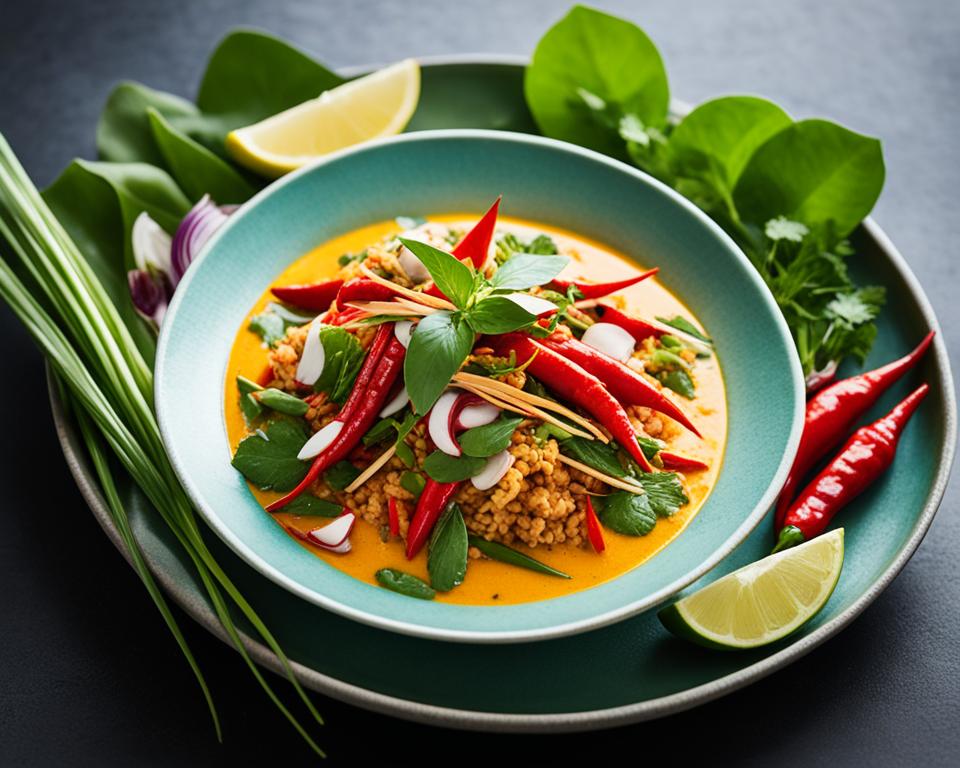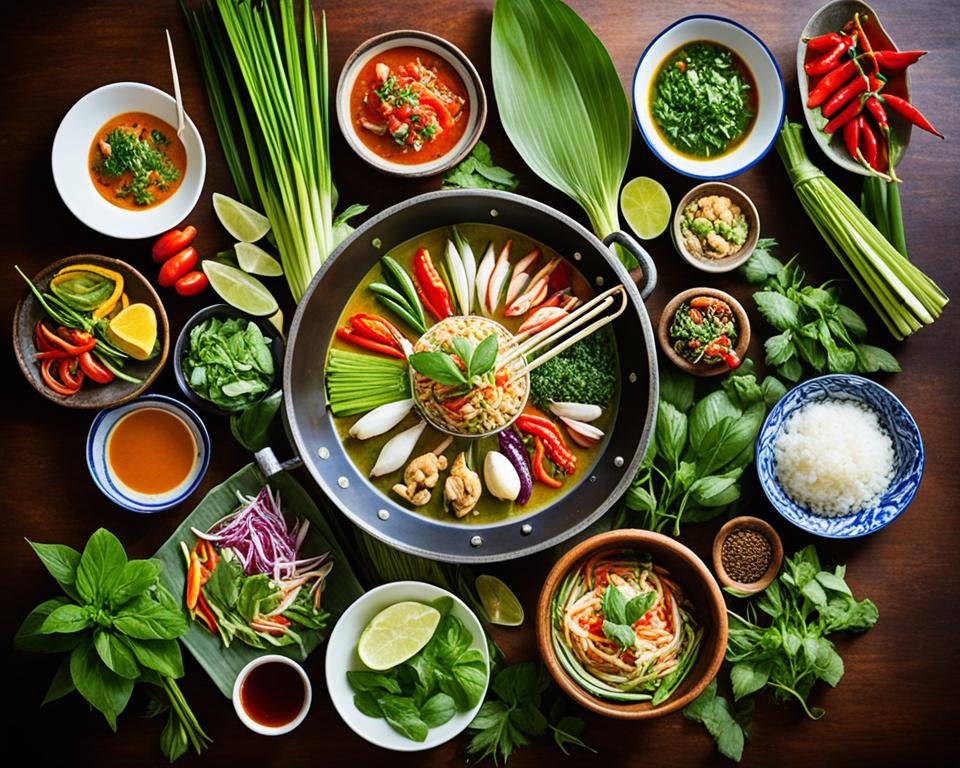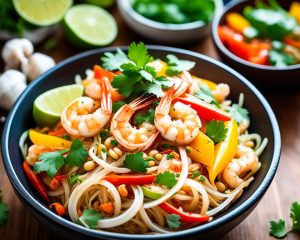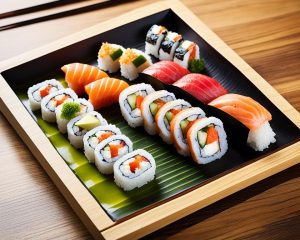Is Thai Food Asian or Indian: A Culinary Exploration

The intriguing question of whether Thai food should be classified as Asian or Indian cuisine has long been a topic of discussion among food enthusiasts and culinary scholars. This article delves into the origins, flavors, and cultural influences that shape the distinct identity of Thai cuisine, unraveling the unique blend of Asian and Indian elements that make it so captivating. By exploring the geographical location, historical roots, and shared characteristics with other regional cuisines, we will discover the fascinating story behind this renowned culinary tradition.
Situated at the crossroads of diverse civilizations and trade routes, Thailand has served as a melting pot of cultural influences, all of which have left an indelible mark on its cuisine. From the spice-infused aromas of Indian dishes to the vibrant flavors of Southeast Asian food, Thai cuisine has evolved into a harmonious fusion, seamlessly blending elements from various culinary traditions.
As we delve deeper into the origins and characteristics of Thai food, we will uncover the intricate tapestry of Asian and Indian culinary influences that have shaped this renowned gastronomic tradition. Join us on a captivating journey to explore the essence of Thai cuisine and determine its rightful place in the pantheon of global regional cuisines.
Read more interesting information at ::googrekas
Exploring the Origins of Thai Cuisine
To understand the origins of Thai cuisine, it is essential to consider Thailand’s unique geographic location and the rich cultural influences that have shaped its culinary traditions over time. Situated in the heart of Southeast Asia, Thailand has served as a crossroads for various civilizations, trade routes, and migratory patterns, all of which have left an indelible mark on its food.
Geographical Location and Cultural Influences
Thailand’s strategic position, nestled between the Asian and Indian subcontinents, has allowed it to absorb and blend culinary traditions from both regions. The country’s proximity to Southeast Asian nations, such as Malaysia, Indonesia, and Vietnam, has also contributed to the rich tapestry of Thai cuisine, as it has embraced and adapted influences from these neighboring regional cuisines.
Tracing the Historical Roots
The historical roots of Thai cuisine can be traced back to ancient Thai kingdoms, where the interplay of cultural influences from China, India, and the Malay Peninsula shaped the development of the country’s distinctive culinary traditions. Over the centuries, Thai cooks have skillfully blended these diverse flavors and ingredients to create the vibrant and captivating Thai cuisine we know and love today.
Thai Food: A Blend of Asian Flavors
When examining the flavors and characteristics of Thai cuisine, it becomes evident that it exhibits a strong affinity with other Asian culinary traditions, particularly those found in Southeast Asia. This alignment can be attributed to the shared ingredients and cooking techniques that Thai food shares with its regional counterparts.
Shared Ingredients and Cooking Techniques
The Thai kitchen is a melting pot of Asian culinary influences, drawing inspiration from the diverse regional cuisines of the continent. At the heart of Thai dishes are shared ingredients such as lemongrass, galangal, kaffir lime leaves, and a variety of aromatic herbs and spices. These elements are commonly found in other Southeast Asian cuisines, creating a harmonious blend of flavors that transcend national borders.
Furthermore, the cooking techniques employed in Thai cuisine bear striking similarities to those found in other Asian culinary traditions. The use of wok-frying, steaming, and grilling are all integral to the preparation of Thai dishes, reflecting the cultural influences that have shaped this vibrant and dynamic cuisine.
Similarities with Other Southeast Asian Cuisines
Beyond the shared ingredients and cooking methods, Thai cuisine also exhibits striking similarities with the culinary traditions of its Southeast Asian neighbors. Dishes like Pad Thai, Tom Yum Goong, and Som Tam bear close resemblance to the signature offerings of Indonesian, Malaysian, and Vietnamese cuisines, respectively. This cross-pollination of flavors and techniques underscores the deep-rooted cultural influences that have shaped the diverse tapestry of Asian regional cuisines.
The Distinctive Taste of Indian Cuisine
While Thai cuisine shares numerous affinities with its Asian counterparts, it also exhibits distinct characteristics that set it apart, particularly when compared to the culinary traditions of the Indian subcontinent. Indian cuisine is renowned for its complex and deeply flavored dishes, often characterized by the liberal use of spice blends and aromatic masalas.
Spice Blends and Aromatic Masalas
The foundation of Indian cuisine lies in its intricate spice blends and aromatic masalas. These complex mixtures of herbs, spices, and sometimes nuts or seeds, create the distinctive flavor profiles that are the hallmark of Indian cooking methods. From the fragrant garam masala to the fiery chili-based curry pastes, these spice combinations infuse Indian dishes with layers of depth, warmth, and complexity that are rarely found in other cuisines.
| Common Indian Spice Blends | Key Ingredients | Flavor Characteristics |
|---|---|---|
| Garam Masala | Cumin, coriander, cardamom, cinnamon, cloves, black pepper | Warm, earthy, and aromatic |
| Curry Powder | Turmeric, coriander, cumin, chili peppers, fenugreek, mustard seeds | Pungent, spicy, and complex |
| Chili Masala | Chili peppers, cumin, coriander, garlic, ginger | Fiery, slightly sweet, and pungent |
These aromatic masalas and spice blends are not only essential to the distinct flavor profiles of Indian cuisine but also play a crucial role in its cooking methods, infusing dishes with complexity, depth, and a unique sense of place.
Comparing Thai and Indian Culinary Traditions
As we delve deeper into the culinary traditions of Thailand and India, it becomes evident that while they share some common threads, they also exhibit distinct differences in their flavor profiles, ingredient usage, cooking methods, and presentation styles.
Flavor Profiles and Ingredient Usage
Thai cuisine is known for its bold and vibrant flavors, often striking a harmonious balance between sweet, sour, salty, and spicy elements. The liberal use of ingredients like fresh herbs, lemongrass, kaffir lime leaves, and fish sauce contributes to the distinctive taste of Thai dishes. In contrast, Indian cuisine is renowned for its complex and deeply layered flavors, often derived from the generous application of aromatic spice blends and masalas.
Cooking Methods and Presentation Styles
The cooking methods employed in Thai and Indian cuisines also differ significantly. Thai food often relies on rapid, high-heat techniques like stir-frying and steaming, resulting in dishes that are lively and fresh. Indian cuisine, on the other hand, frequently utilizes slower, more intricate cooking processes, such as simmering and braising, to develop the depth and richness of its flavor profiles. Additionally, the presentation styles of these two culinary traditions vary, with Thai dishes often featuring vibrant colors, garnishes, and a focus on balancing textures, while Indian meals tend to be more centered on the harmonious blending of spices and ingredients.
These cultural differences in flavor profiles, ingredient usage, cooking methods, and presentation styles contribute to the distinct and captivating identities of Thai and Indian cuisines, each offering a unique and delectable culinary experience.
Is Thai Food Asian or Indian?
Considering the distinct characteristics of Thai cuisine and Indian cuisine, the question of whether Thai food should be classified as Asian or Indian cuisine becomes a complex and nuanced one. This debate has been the subject of much discussion among food scholars and enthusiasts.
Understanding the Culinary Classification
Thai food exhibits a remarkable blend of influences, drawing from both the broader culinary traditions of Southeast Asian countries as well as the distinctive flavors and cooking techniques of the Indian subcontinent. This fusion of Asian and Indian elements has led to an ongoing debate about the cultural classification of Thai cuisine.
Embracing the Diversity of Flavors
Ultimately, the debate over whether Thai food is more Asian or Indian in nature is less about strict categorization and more about embracing the remarkable diversity of flavors that define this captivating culinary tradition. Thai cuisine is a testament to the harmonious blending of culinary influences, creating a unique and captivating gastronomic experience.
Regional Variations in Thai Cuisine
While Thai cuisine is often viewed as a unified and cohesive culinary tradition, it is important to recognize the significant regional variations that exist within the country. Thailand’s diverse geography, ethnic groups, and historical influences have contributed to the development of distinct regional cuisines, each with its own unique flavor profiles and culinary practices.
Northern Thai Dishes
In the northern regions of Thailand, the local cuisine reflects the cooler climate and proximity to the mountainous terrain. Dishes such as khao soi, a rich and aromatic curry noodle soup, and laab, a spicy salad made with minced meat, are hallmarks of northern thai cuisine. These dishes often feature the use of ingredients like fresh herbs, fermented fish sauce, and a more pronounced use of chili peppers, resulting in bold and complex flavors.
Southern Thai Specialties
Traveling to the southern regions of Thailand, one is greeted with a distinct and captivating culinary landscape. The coastal regions and tropical climate have influenced the development of dishes that heavily incorporate seafood and coconut milk. Iconic southern thai specialties include massaman curry, a fragrant and creamy curry with influences from the Malay Peninsula, and tom yum goong, a spicy and sour shrimp soup that is renowned for its bold and harmonious flavors.

These regional variations in Thai cuisine not only highlight the cultural diversity of the country but also reflect the adaptability and creativity of Thai cooks in harnessing the abundance of local ingredients and adapting to their unique environments. From the aromatic and robust flavors of the north to the rich and vibrant dishes of the south, Thai cuisine continues to captivate and delight food enthusiasts around the world.
Thai Food: A Harmonious Fusion
At the heart of the debate over whether Thai cuisine is more closely aligned with Asian food or Indian cuisine lies the profound and harmonious fusion that defines this culinary tradition. Thai food is a testament to the ability to seamlessly blend diverse cultural influences and adapt flavors to create a unique and captivating gastronomic experience.
Blending Influences and Adapting Flavors
The Thai culinary adaptation is a result of centuries of flavor blending and the integration of ingredients and techniques from various regional cuisines. From the distinctive aromatic spices of India to the vibrant herbs and produce of Southeast Asia, Thai chefs have masterfully combined these elements to craft a cuisine that is truly extraordinary.
The ability to harmonize such diverse cultural influences is what makes Thai cuisine so captivating and unique. By skillfully balancing the bold flavors of Indian cuisine with the fresh, fragrant notes of Asian food, Thai cooks have created a culinary landscape that is both familiar and exotic, comforting and adventurous.
This harmonious fusion is what gives Thai food its distinct identity, setting it apart from other regional cuisines. It is a testament to the country’s rich cultural heritage and the adaptability of its culinary traditions, constantly evolving to incorporate new influences while maintaining a strong sense of its own unique character.
Popular Thai Dishes and Their Origins
As we delve deeper into the distinct identity of Thai cuisine and its relationship to Asian and Indian culinary traditions, it is illuminating to examine some of the most iconic and beloved Thai dishes and their origins. From the national treasure of Pad Thai to the spicy delight of Tom Yum Goong, these beloved Thai dishes showcase the harmonious blending of flavors and the rich cultural heritage that define this captivating cuisine.
Pad Thai: A National Treasure
Pad Thai, a stir-fried rice noodle dish, is widely regarded as the quintessential Thai cuisine and has become a global ambassador for the country’s culinary prowess. While the exact origins of Pad Thai are debated, it is believed to have emerged as a national dish in the 1930s, when the Thai government sought to promote a unified national identity through the standardization of traditional Thai dishes. The dish’s unique flavor profile, which combines sweet, sour, and savory elements, is the result of a harmonious fusion of Chinese and Thai influences, reflecting the cultural exchange that has shaped the culinary origins of Thai cuisine.
Tom Yum Goong: A Spicy Delight
Another iconic Thai dish that has captivated the global palate is Tom Yum Goong, a fragrant and spicy shrimp soup. This beloved Thai cuisine staple showcases the depth and complexity of Thai flavor profiles, blending sour, spicy, and herbal notes to create a truly unique and memorable taste experience. The origins of Tom Yum Goong can be traced back to the central and southern regions of Thailand, where the dish’s signature mix of lemongrass, kaffir lime leaves, galangal, and fresh shrimp have been perfected over generations.
These two popular Thai dishes – Pad Thai and Tom Yum Goong – not only exemplify the distinct identity of Thai cuisine but also highlight the rich cultural heritage and the harmonious fusion of influences that have shaped this captivating culinary tradition.

Indian Influences in Thai Cuisine
While Thai cuisine is firmly rooted in the broader culinary traditions of Asia, it has also been significantly influenced by the flavors and cooking practices of the Indian subcontinent. The exchange of ingredients, spices, and culinary techniques between Thailand and India has left an indelible mark on the development of Thai food.
Curry Pastes and Coconut Milk
One of the most prominent Indian influences on Thai cuisine can be seen in the use of curry pastes and coconut milk. Thai curries, such as red curry and green curry, share a strong resemblance to their Indian counterparts, with the incorporation of spice blends and the creamy texture provided by coconut milk. This harmonious fusion of Thai and Indian elements has resulted in the creation of some of the most beloved Thai dishes.
Borrowed Spices and Ingredients
The culinary exchange between Thailand and India has also led to the adoption of various spices and ingredients that have become integral to Thai cuisine. From the aromatic cumin and coriander to the fiery chili peppers, many of the distinctive flavors found in Thai food can be traced back to the vibrant spice trade and culinary traditions of the Indian subcontinent.
| Shared Ingredients | Cooking Techniques |
|---|---|
| Coconut milk, curry pastes, lemongrass, kaffir lime leaves, galangal | Simmering, grilling, steaming, stir-frying |
| Cumin, coriander, turmeric, chili peppers, ginger | Blending and pounding spices, using mortar and pestle |
The Global Appeal of Thai Food
The unique and captivating flavors of Thai cuisine have transcended its regional boundaries and gained widespread popularity around the world. As Thai food has become increasingly accessible and appreciated on a global scale, it has also undergone adaptations and interpretations that further highlight its versatility and appeal.
The popularity of Thai cuisine can be attributed to its bold, harmonious blend of sweet, sour, spicy, and savory flavors, as well as its use of fresh, vibrant ingredients. Dishes like Pad Thai, Tom Yum Goong, and Massaman Curry have become staples on menus from New York to Tokyo, introducing the world to the rich tapestry of Thai culinary traditions.
Popularity and Adaptations Worldwide
As Thai food has gained global recognition, it has also inspired creative interpretations and adaptations by chefs and home cooks around the world. From fusion dishes that blend Thai flavors with local ingredients to innovative takes on classic Thai recipes, the versatility of Thai cuisine has allowed it to seamlessly integrate into diverse culinary landscapes. This global appeal has not only introduced more people to the unique flavors of Thailand but has also fostered a deeper appreciation for the country’s rich cultural heritage.







